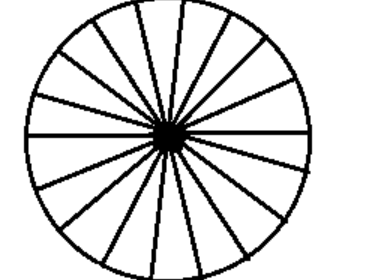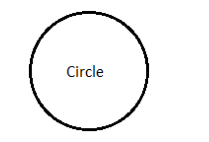
A circle with diameter 8 cm is divided into 18 equal parts as shown below. Find the area of one region among the 18 square parts. ( \[Take\ \pi \ =\text{ }3.14\] )

A. 2.791 \[c{{m}^{2}}\]
B. 5.024 \[c{{m}^{2}}\]
C. 1.432 \[c{{m}^{2}}\]
D. 3.836 \[c{{m}^{2}}\]

Answer
501.3k+ views
Hint: Before solving this question, we must learn about a circle.
CIRCLE: A circle is a round, two-dimensional shape. It is a curve, a closed curve. It is not a polygon because it does not have any straight lines. All points on the edge of the circle are at the same distance from the center.

For the solution of this question, we will firstly calculate the area of this circle.
The formula to calculate the area of the circle is \[\pi {{r}^{2}}\].
Complete step-by-step answer:
After calculating the area of this circle, we will divide it by 18, as this circle is divided into 18 parts.
By dividing its area by 18, we shall get the area of one region of this circle.
Let us solve this question now.
Firstly, as mentioned in the steps provided above in the hint, we shall calculate the area of the circle by the formula \[\pi {{r}^{2}}\] .
Diameter of the circle = 8 cm
Radius of the circle= \[\dfrac{8}{2}\] cm
= 4 cm
Area of the circle = \[\pi {{r}^{2}}\]
= \[3.14\ \ \times \ \ {{\left( 4 \right)}^{2}}\]
= \[3.14\ \ \times \ \ 16\]
= 50.24
Area of one region of the circle = \[\dfrac{50.24}{18}\]
= \[\dfrac{5024}{1800}\]
= \[2.791\ c{{m}^{2}}\]
So, the area of one region of this circle is 2.791 \[c{{m}^{2}}\].
Hence, the correct option is (a) 2.791 \[c{{m}^{2}}\].
Note: One must remember the formulas to calculate the areas of different 2 – dimensional shapes.
SQUARE: \[Side\times Side\]
RECTANGLE: \[Length\times Breadth\]
CIRCLE: \[\pi {{r}^{2}}\]
TRIANGLE: \[\dfrac{1}{2}\times Base\times Height\]
RHOMBUS: \[Base\times Height\]
CIRCLE: A circle is a round, two-dimensional shape. It is a curve, a closed curve. It is not a polygon because it does not have any straight lines. All points on the edge of the circle are at the same distance from the center.

For the solution of this question, we will firstly calculate the area of this circle.
The formula to calculate the area of the circle is \[\pi {{r}^{2}}\].
Complete step-by-step answer:
After calculating the area of this circle, we will divide it by 18, as this circle is divided into 18 parts.
By dividing its area by 18, we shall get the area of one region of this circle.
Let us solve this question now.
Firstly, as mentioned in the steps provided above in the hint, we shall calculate the area of the circle by the formula \[\pi {{r}^{2}}\] .
Diameter of the circle = 8 cm
Radius of the circle= \[\dfrac{8}{2}\] cm
= 4 cm
Area of the circle = \[\pi {{r}^{2}}\]
= \[3.14\ \ \times \ \ {{\left( 4 \right)}^{2}}\]
= \[3.14\ \ \times \ \ 16\]
= 50.24
Area of one region of the circle = \[\dfrac{50.24}{18}\]
= \[\dfrac{5024}{1800}\]
= \[2.791\ c{{m}^{2}}\]
So, the area of one region of this circle is 2.791 \[c{{m}^{2}}\].
Hence, the correct option is (a) 2.791 \[c{{m}^{2}}\].
Note: One must remember the formulas to calculate the areas of different 2 – dimensional shapes.
SQUARE: \[Side\times Side\]
RECTANGLE: \[Length\times Breadth\]
CIRCLE: \[\pi {{r}^{2}}\]
TRIANGLE: \[\dfrac{1}{2}\times Base\times Height\]
RHOMBUS: \[Base\times Height\]
Recently Updated Pages
Master Class 9 General Knowledge: Engaging Questions & Answers for Success

Master Class 9 English: Engaging Questions & Answers for Success

Master Class 9 Science: Engaging Questions & Answers for Success

Master Class 9 Social Science: Engaging Questions & Answers for Success

Master Class 9 Maths: Engaging Questions & Answers for Success

Class 9 Question and Answer - Your Ultimate Solutions Guide

Trending doubts
Fill the blanks with the suitable prepositions 1 The class 9 english CBSE

What is the color of ferrous sulphate crystals? How does this color change after heating? Name the products formed on strongly heating ferrous sulphate crystals. What type of chemical reaction occurs in this type of change.

How do you graph the function fx 4x class 9 maths CBSE

Difference Between Plant Cell and Animal Cell

The largest oil field of India is A Digboi B Bombay class 9 social science CBSE

What is pollution? How many types of pollution? Define it




